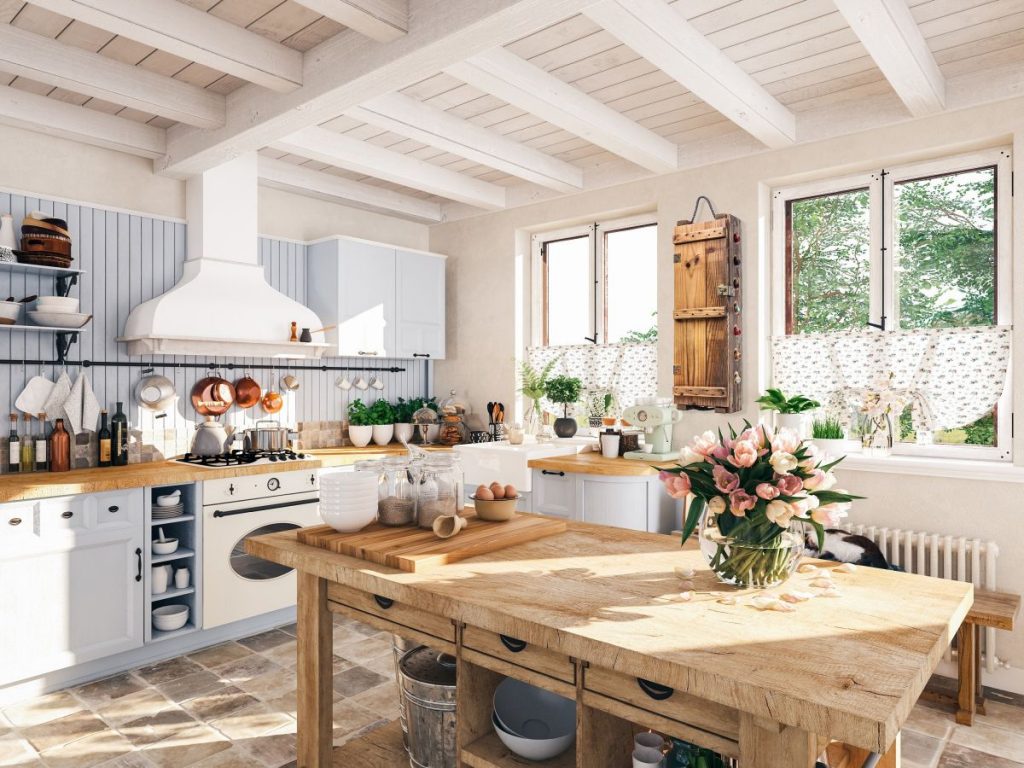In a world where the pace of life seems to be perpetually accelerating, the allure of Cottagecore interior design beckons with promises of simplicity, nostalgia, and sustainability.
Step into the enchanting realm of Cottagecore, where the romantic and nature-oriented design characteristics converge to create cosy living spaces that harken back to a bygone era.
This interior design style is more than just an aesthetic trend–it’s a philosophy that invites us to reimagine our connection to the land, embrace a slower pace of life, and cultivate a deeper bond with the world outside our windows.
Delve into the heart of Cottagecore, uncover the key elements that define this style, explore its distinctive colour palette, and discover how to infuse your living space with its irresistible charm.
What Is Cottagecore Interior Design
The romantic and nature-oriented characteristics of cottagecore interior design call for cosy living spaces.
Usually, they’re decorated with rustic touches and furnished with everything you need for a comfortable, happy and productive life. It’s meant to recall the rural culture and bring greenery inside the living space.
The key characteristics of the cottagecore style are simplicity, comfort, self-reliance, and personal freedom, particularly in the countryside.
It encourages a lifestyle that uses traditional skills such as baking bread, gardening, sewing clothes, and gathering herbs and other ingredients. It’s the desire to live in a world outside of the one currently inhabited.
It’s a slow lifestyle without pinging phones with constant updates and urgent work emails. In the cottagecore style, there is no labour beyond the domestic one. Workday tasks are seen as a side part of life that brings a sense of fulfilment. It focuses on living in the present.
Cottagecore is an inherently sustainable style that encourages reconnecting with the land. It aims to confront climate change and think about what we can do about it and care for the earth.
It encourages swapping plastic for reusable wood and glass materials. It invites you to start gardening and rely more on yourself and your community than mass manufacturing. The cottagecore style generally reminds us to slow down and live more consciously.
The house is considered a space for cultivation rather than storage.
C cottagecore reminds us to honour the earth and live more holistically by caring about the things outside our windows. The style is about pretending to live an idyllic life outside modern society.
This is precisely where the name “cottagecore” comes from – a reference to rural cottages, quaint dwellings with lots of charm.
It’s important to note that cottagecore doesn’t share minimalism’s focus on negative space and clean lines despite focusing on a simple lifestyle. It embraces more clutter as a sign of life and inhabitation.
Through this, it radiates organic interior as a rejection of the modern and a turn towards what was once the norm but is now disappearing. Typically, cottagecore is a financially low-maintenance style.
Key Elements of Cottagecore Design
Cottagecore is about all things natural and nature-related.
A cottagecore interior design is full of potted plants, rustic wooden furniture and vintage decor pieces, all of which relate to nostalgia for the simple and self-reliant lifestyle of the past. Dried herbs in the kitchen, for example, perfectly represent that.
Other decorative elements that go with cottagecore design are skeins of yarn kept in woven baskets, glass jars full of ingredients on the kitchen counters or shelves and a stack of books on the bedside table.
Things like floral prints, natural materials and indoor plants are the main cottagecore elements that allude to the pre-industrial homes and by which the trend is inspired.
According to the cottagecore style, you should try making most of your belongings yourself or thrifting them rather than buying mass-produced products.
Once you know the basics of cottagecore, there are a few principles to stick to when designing your interior:
- Use natural materials. Cottagecore and nature are inherently connected. Make use of wood, wicker, hemp and other types of raw materials. Try including woven baskets of extra blankets, wooden chairs and a macrame piece made of hemp. Furniture and decor made from these materials are cottagecore essentials.
- Go for antique furniture. Antique style, vintage and thrifted furniture with a farmhouse or French influence is a key element for a cottagecore interior design. It creates a nostalgic feeling for the simple life of the past. Chipped paint or faded fabrics are very suitable as they show signs that the object has been used and reused following sustainability principles. Imperfections add to a cottagecore home’s charm.
- Play with colour and textures. Earth tones and floral patterns make up the cottagecore aesthetic since it relies on a more electric mix of colour and texture. Lace cloths, wooden furniture, quilted throws, and worn-out velvet chairs are typical in this style.
- Opt for floral wallpapers. Cottagecore brings wallpaper back in style. Especially vintage, floral and nature-inspired ones. They make a stunning backdrop for the interior design. If you dislike the hassle of putting up wallpaper, cover just one wall for an accent.
- Add soft furnishings. Pillows, long curtains, rugs, and quilts add to the overall cottagecore look. Your home should feel as comfortable as it looks.
- Hang handmade pieces. These decor elements, made by you or someone else, are the perfect finishing touches for a cottagecore interior design. Homemade elements like cross-stitch pieces or flower-pressing are the perfect decorative elements. Whatever craft or hobby you take up, display the finished results.
- Develop sustainable habits. Start gardening or plant a few pots with herbs. Take up composting. One of Cottagcore’s main focuses is connecting with nature and caring for it.
- Bring greenery indoors. Displaying freshly cut flowers is the perfect way to embrace Cottagecore’s ties to nature. To level it up, find flowers native to your region.
- Put ingredients on display. Home-making activities, like cooking and baking, are strongly associated with the cottagecore style. Leave dry ingredients, herbs and produce (items that don’t require refrigeration) out in visible places.
- Add nature-related art. Pieces that emphasise nature, such as landscape paintings, polaroid photographs and nature prints, enhance the overall look of your home. They provide you with the opportunity to personalise your living space.
The Cottagecore Color Palette
Primarily, cottagecore includes warm colours and dainty floral patterns. Its colour palette should remind of a Renaissance oil painting – brown, green and floral-inspired pastels. The details of cottagecore design are usually understated with neutral shades.
Layers of complementary shades like beige, cream and greige prevent the interior from looking plain and too strict.
Creating Your Cottagecore Sanctuary
All the materials and textures should be natural when designing your living space in the cottagecore style.
Start with vintage furniture. Antique pieces, especially ones with a rustic farmhouse look, are essential for a cottagecore interior design. Let the space feel full and lived-in.
Some people don’t like an overly cluttered home, but objects scattered around the room, showing signs of life, are a significant component of this style. Leaving certain useful objects out makes their access easier and gives a Cottagecore home a cosy charm.
Add soft furnishings. Cosy throws, overstuffed pillows, long curtains and other soft materials make a house feel like a welcoming home.
Plants and flowers are a must for a cottagecore interior design. They are relatively inexpensive items to decorate your home with, making it more beautiful and providing significant health benefits.
Attempting to make the majority of your belongings doesn’t mean sewing all your clothes or consuming exclusively home-grown produce all the time.
You can do something as small as planting a few herbs in pots or a vertical garden and placing them on a kitchen or porch windowsill. You can go for a full garden if you have a yard and enough space.
Hanging DIY dried bouquets is also a common cottagecore decor piece. The key is to connect with nature and try to live as sustainably as possible. Ideally, this style gives you a feeling of fulfilment and peace.
A cottagecore home should be your place of comfort, utility and reflection. Fill it with plenty of natural light. Leave cookware out in visible places between uses. Do the same with other objects such as books.
In your journey to transform your interior in the Cottagecore style, you may find the expertise of a handyperson invaluable.
Whether it’s restoring vintage furniture, creating custom wooden pieces, or even installing shelving for your ever-growing collection of rustic decor, your local licensed handyman can help bring your Cottagecore vision to life.
They can also assist in practical aspects such as ensuring your home is well-maintained and safe, allowing you to enjoy the cosy and sustainable lifestyle that Cottagecore promotes fully.
The Origins and Influence of Cottagecore
You’ve probably seen the cottagecore aesthetic become popular on TikTok or Instagram. It has been circulating recently, especially after the pandemic, because more people have started to seek comfort in nature and strive to live a more sustainable lifestyle.
Trapped at home, people gain a better appreciation for simple tasks like cooking, baking and crafting, even just walking outside.
Cottagecore became a way to embrace something inescapable: redecorating your living space to make it cosier and bringing the outside inside since people couldn’t go out as often. Aesthetic trends are a result of the events that happen around us.
In reality, cottagecore originates way back in the ancient Greek countryside. People from different parts of the world have lived this way for centuries. During the French Revolution, European nobility similarly moved to the countryside, seeking simpler lives.
However, with the advancement of technology and the Industrial Revolution, larger cities became the main residence sites, and many people moved away from this style of simple living.
In recent years, because of the way technology has overwhelmed us while we were locked in our homes, more and more people started seeking ways to return to our roots and nature.
They become inspired by a less complicated way of life, romanticising what “staying at home” can look like. Cottagecore creates a simple, dream-like fairy tale world.
It’s no surprise that in modern times, with a pandemic, political upheaval and climate change becoming inevitable, people would search for a forgotten, simple lifestyle detached from reality. It’s common for society to turn towards the past to soothe the present.
For discriminated minority communities, like LGBTQ+ and people of colour, the cottagecore lifestyle and aesthetic offer a safe and welcoming space.
For Black women, in particular, cottagecore offers a reactionary chance to push against colonialism and formerly segregated areas, the consequences of which persist today. It allows them to reclaim domestic femininity, which has been historically denied.
Conclusion
Nowadays, in a world of constant connectivity, Cottagecore is a gentle reminder of the beauty of simplicity, self-reliance, and a deeper connection to nature. It encourages us to slow down, embrace imperfections, and nurture a sense of fulfilment in everyday life.
Cottagecore’s enduring appeal has transcended the digital realms of TikTok and Instagram, resonating with people from all walks of life. It offers a sanctuary of comfort and nostalgia, where vintage treasures and natural elements blend seamlessly to create spaces that feel like home.
Moreover, Cottagecore has become a beacon for those who seek sustainable living practices, reminding us to care for the earth and reconnect with the land.
As we adapt Cottagecore principles into our living spaces, we are not merely following a trend; we consciously choose to honour nature, cherish the past, and embrace a more holistic way of life.
Whether you’re adorning your home with potted plants, vintage decor, or handmade crafts doesn’t matter. Just remember that Cottagecore is not just about aesthetics. It’s about cultivating peace, fulfilment, and a deep connection to the world outside our windows.
It’s a journey back to the simple, the sustainable, and the serene—a journey well worth taking in our fast-paced world.



